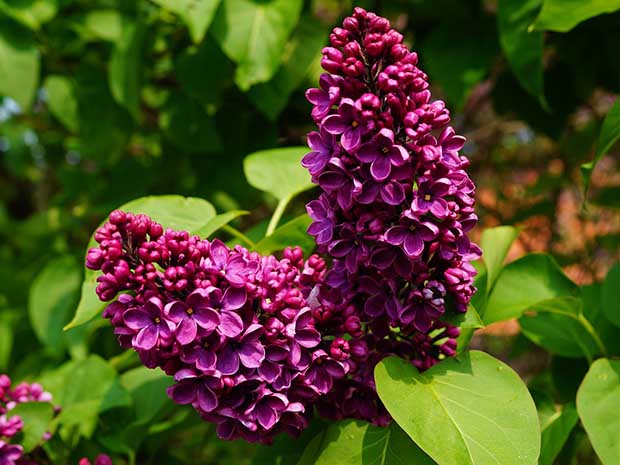This month is what it’s all about!
Many of the items you buy or tasks you do right now, will have a big effect on your outdoor spaces right up until fall. This checklist may help you organize!
Look – at our April Garden Tips in case you missed something that you can still accomplish.
An Important Note About Winter Burn Winter burn can show up no matter what kind of winter we’ve had. If you have evergreens that have brown or rust colored areas, click here to take a look at our recommendation about what to do.
Feed – roses with a well-balanced food. Espoma’s Rose-Tone is a great choice. You can go with any general plant food as long as the nutrient ratio is low. (Lots of rose gardeners have their own thoughts or even recipes for feeding, so you may want to investigate this topic on trusted websites or someone you know who has great roses.)
Feed – Shrubs and Trees – Apply a time-released fertilizer such as Plant-Tone or Holly-Tone (for acid-loving shrubs). You can also scratch this in around big-leaf, repeat blooming hydrangeas such as ‘Endless Summer’, Penny Mac’ and ‘Blushing Bride’.
Feed – Perennials – Plant-tone or Osmocote to heavy-feeding perennials that quickly deplete nutrients from the soil. These ‘fast eaters’ benefit from a slow, steady release of fertilizer over three to four months. Follow the container’s directions for the application rate, scratch it into the soil around the plant, and water in.
Which perennials are major candidates for a time-released fertilizer? Delphinium, Clematis, Astilbe and bulbs in the Lilium family (i.e., Asiatic, Trumpet, Orienpets and Oriental lilies).
Watch – roses for insects and diseases. Wet weather, in particular, can cause problems for roses. If you see something starting, you may want to consider spraying with a fungus and disease control. Just as with feeding, many rose gardeners have their own recipes and solutions for disease control.
Prune – Shrubs & trees that have already flowered this spring. Prune as soon as flowering finishes. This is not the time for remodeling your plant! Wait until next year for major pruning unless you’re cutting back lilacs or forsythia if they need it.
Cut Back – dead foliage from early spring plants such as tulips, daffodils, and hyacinths. Make sure to wait until foliage has completely died as the bulb takes nutrients from the living leaves back and stores it for next year.
Apply – Step two of your lawn program to eliminate broadleaf weeds and to feed the lawn if it has been at least 30 days since you put down Step one. After mowing, grass clippings can go into the compost.
Check – peonies for botrytis or other fungal issues. If your peonies suffered from any disease or bud blast the year before, it should be sprayed regularly this year, starting when the plants have emerged to a few inches. Peonies fare much better if planted with adequate sun, air circulation, and good soil drainage.
Check plants for aphids – if any are seen, they are very easy to get rid of. Use SAFER insecticidal soap. Follow this link to find out how to identify aphids?
Plant – annuals, perennials, herbs, and vegetables. (In our area, our last frost is usually mid-month. If we do get an unseasonable frost, bring hanging baskets and containers inside. For planted annuals, throw a sheet or other light fabric over them. Don’t use plastic if you can help it. This can cause condensation which can freeze.
For annuals, it’s a good idea to pinch off flowers on plants just purchased. This will encourage a fuller habit and more buds.
For newly purchased perennials and shrubs whose roots are pot-bound, make a few cuts in the roots and pull the sections apart a little when planting.
Plant water garden plants later in the month when the water temperature is over 65 degrees.
Plant summer- and fall-flowering bulbs such as Asiatic and Oriental lilies, dahlias, peacock orchids (Acidanthera), cannas, tuberous begonias, caladium, crocosmia, freesia, gladioli, montbretia, and calla lilies.
Plant trees & shrubs following our planting instructions.
Transplant – Any plants you started from seed after thinning.
Edibles – Sow seeds directly into the garden after Mid-May; cucumbers, corn, beans, watermelon, pumpkins, summer squash, and herbs.
Transplant seedlings or purchased plants into the garden in Mid-May.
Begin to Move – houseplants & tropicals outside. This needs to be a gradual process so you don’t shock your plants.
The 2 rules of moving outdoors in the Spring:
Nights must consistently be 45 degrees or above for the plant to stay outside without protection.
Don’t put plants that have been indoors or even in a greenhouse directly into full sun. Put them in shade to begin with and move into part sun or full sun (depending on the plant’s ultimate need) over the span of a couple of weeks. Plants can get sunburn, so moving them straight into full sun can be a disaster. You can trim and feed overwintered houseplants at this point.
Flowering Plant Care – Tall perennials will need staking now before you get into a wrestling match with stems and leaves! Watch vines for growth and help them to stay on their trellis or other structure when they need it.
Watering! – Watch your window boxes, hanging baskets and container gardens. The weather affects these plantings greatly. On warm and/or windy days, moisture can disappear quickly!
The best way to determine water needs in containers is to give them a lift. Note how heavy the container is when you’ve done a very thorough watering. Continue to give the edge of a container a little lift and see how heavy or light it feels. Push up on the bottoms of hanging baskets. Soon, you’ll be able to judge when to water, as the container will feel light.
For proper watering of new plantings check out our instructions

